
Hieronymus Bosch was a Dutch painter from Brabant. He is one of the most notable representatives of the Early Netherlandish painting school. His work, generally oil on oak wood, mainly contains fantastic illustrations of religious concepts and narratives. Within his lifetime, his work was collected in the Netherlands, Austria, and Spain, and widely copied, especially his macabre and nightmarish depictions of hell.

Ship of Fools is a painting by the Early Netherlandish artist Hieronymus Bosch, now in the Musée du Louvre, Paris. Camille Benoit donated it in 1918. The Louvre restored it in 2015. The surviving painting is a fragment of a triptych that was cut into several parts. This piece, originally part of a larger body of work relating to the seven deadly sins, depicts the sin of gluttony. The Ship of Fools was painted on one of the wings of the altarpiece, and is about two-thirds of its original length. The bottom third of the panel belongs to Yale University Art Gallery and is exhibited under the title Allegory of Gluttony. The other wing, which has more or less retained its full length, is the Death and the Miser, now in the National Gallery of Art, Washington, D.C. The two panels together would have represented the two extremes of prodigality and miserliness, condemning and caricaturing both. The Wayfarer (Rotterdam) was painted on the right panel rear of the triptych. The central panel, if it existed, is unknown.

The Garden of Earthly Delights is the modern title given to a triptych oil painting on oak panel painted by the Early Netherlandish master Hieronymus Bosch, between 1490 and 1510, when Bosch was between 40 and 60 years old. Bosch's religious beliefs are unknown, but interpretations of the work typically assume it is a warning against the perils of temptation. The outer panels place the work on the Third Day of Creation. The intricacy of its symbolism, particularly that of the central panel, has led to a wide range of scholarly interpretations over the centuries.

The Haywain Triptych is a panel painting by the Early Netherlandish painter Hieronymus Bosch, now in the Museo del Prado, Madrid, Spain. A date of around 1516 has been established by means of dendrochronological research. The central panel, signed "Jheronimus Bosch", measures 135 cm × 200 cm and the wings measure 147 cm × 66 cm. The outside shutters feature a version of Bosch's The Wayfarer.

Cutting the Stone, also called The Extraction of the Stone of Madness or The Cure of Folly, is an oil-on-panel painting completed c.1494 or later by the Dutch painter Hieronymus Bosch. It is now in the Museo del Prado in Madrid.
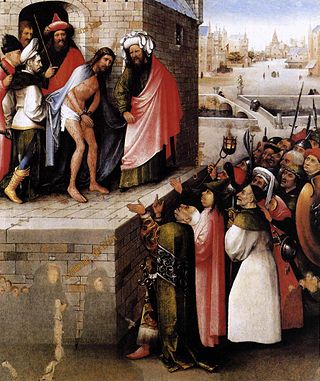
Ecce Homo is a painting of the episode in the Passion of Jesus by the Early Netherlandish painter Hieronymus Bosch, painted between 1475 and 1485. The original version, with a provenance in collections in Ghent, is in the Städel Museum in Frankfurt; a copy is held the Museum of Fine Arts in Boston. The painting takes its title from the Latin words Ecce Homo, "Behold the Man" spoken by the Roman Prefect Pontius Pilate when Jesus is paraded before a baying, angry mob in Jerusalem before he is sentenced to be crucified.
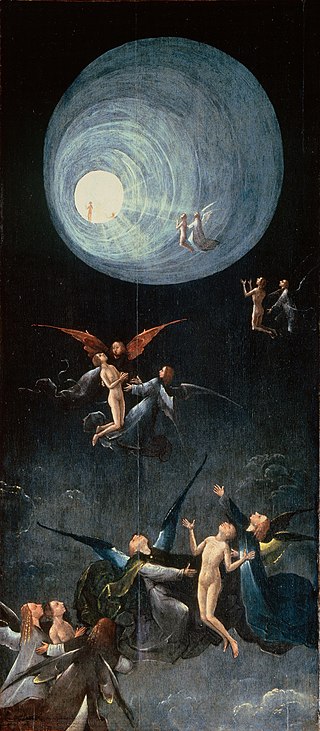
Ascent of the Blessed is a Hieronymus Bosch painting made between 1505 and 1515. It depicts angels helping human souls towards heaven. The attribution to Bosch is not universally accepted.
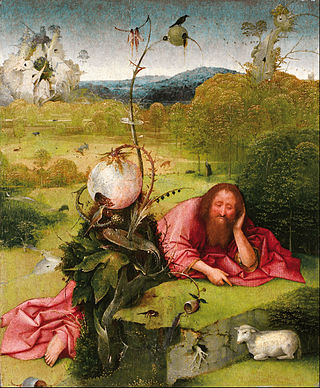
St. John the Baptist in the Wilderness is an oil painting on panel by the Netherlandish artist Hieronymus Bosch, created c. 1489. The painting was acquired by the Spanish collector Lázaro Galdiano in 1913. It is on display in the Lázaro Galdiano Museum, in Madrid, Spain.

This is an incomplete list of drawings by Hieronymus Bosch, many of which have survived to the present day. A number represent alternate incarnations or preparatory sketches for his paintings.
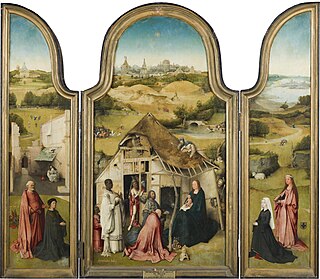
The Adoration of the Magi or The Epiphany is a triptych oil painting on wood panel by the Netherlandish artist Hieronymus Bosch, executed around 1485–1500. It is now in the Museo del Prado in Madrid, Spain.

Christ Carrying the Cross is a painting attributed to a follower of Hieronymus Bosch. It was painted in the early 16th century, presumably between 1510 and 1535. The work is housed in the Museum of Fine Arts in Ghent, Belgium. Various aspects of the painting have been a source of scholarly debate. The painting is notable for its use of caricature to provide grotesque-looking faces surrounding Jesus and is an expression of Bosch's pessimistic views. It exhibits Christian imagery and symbolism, deriving its core elements from the Bible.

Christ Carrying the Cross is an oil on panel painting by the Dutch artist Hieronymus Bosch, executed most likely c. 1490–1500. It is at the Kunsthistorisches Museum, in Vienna, Austria.
Head of a Woman is a fragment of a Hieronymus Bosch painting, created c. 1500. It is currently in the Museum Boijmans Van Beuningen in Rotterdam, Netherlands. The fragment is only 13 cm tall and 5 cm wide.
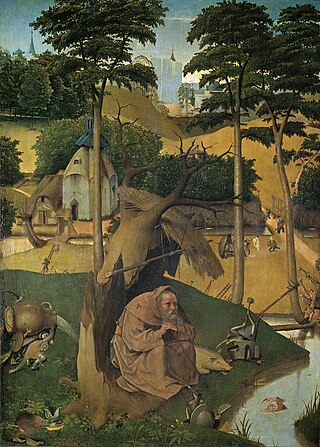
The Temptation of St. Anthony is a painting of disputed authorship, attributed to either the Early Netherlandish artist Hieronymus Bosch or a follower. It is now in the Museo del Prado, in Madrid.

The Last Judgment is a triptych by the Early Netherlandish artist Hieronymus Bosch, created after 1482.

The Adoration of the Magi is an oil painting on wood panel by Netherlandish artist Hieronymus Bosch, executed around 1475. It is housed in the Metropolitan Museum, New York, US. A prominent feature of this painting is the strong perspective effect and also the copious use of gold leaf, which is not very typical for Bosch. The pigments employed are red lake, azurite, lead-tin-yellow and ochres.
Jheronimus Bosch—Visions of Genius was a 2016 art exhibition at the Noordbrabants Museum in 's-Hertogenbosch, the Netherlands, about the work of Hieronymus Bosch, a native of 's-Hertogenbosch.

The Temptation of Saint Anthony is an oil-on-oak, single-panel painting by the Early Netherlandish artist Hieronymus Bosch, executed c.1500-1510. The painting features a scene from the life of Saint Anthony in which he was being tempted to sin by demonic spirits. These creatures have symbolic meanings in this work. These demonic creatures are references to other paintings by Bosch.

Hieronymus Bosch, Touched by the Devil is a 2015 Dutch documentary film directed by Pieter van Huystee about the Dutch artist Hieronymus Bosch. It documents how The Haywain Triptych is exhibited in Bosch's hometown of 's-Hertogenbosch for the first time in almost 500 years.

















